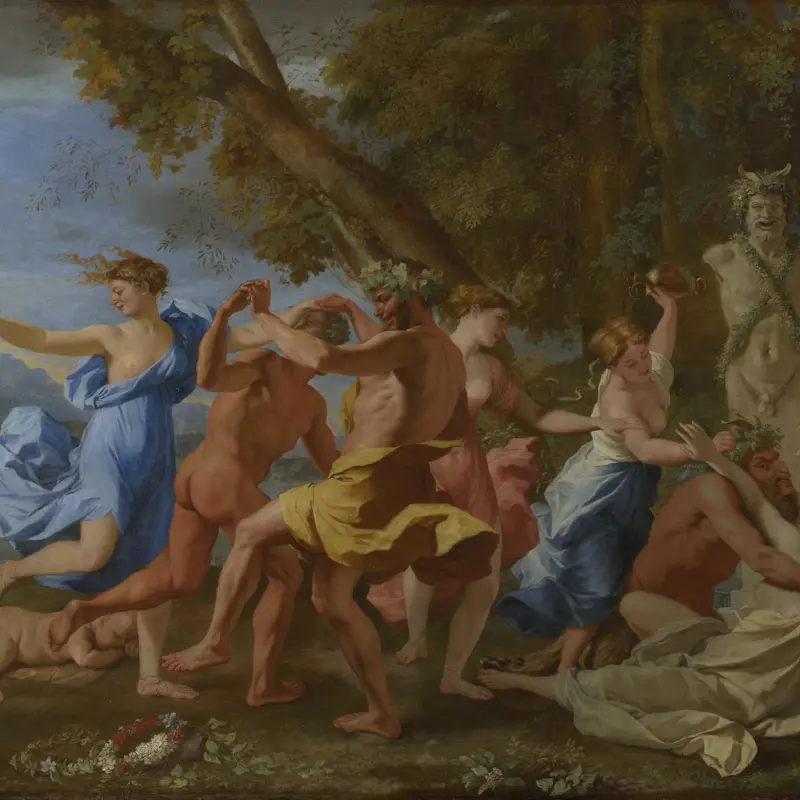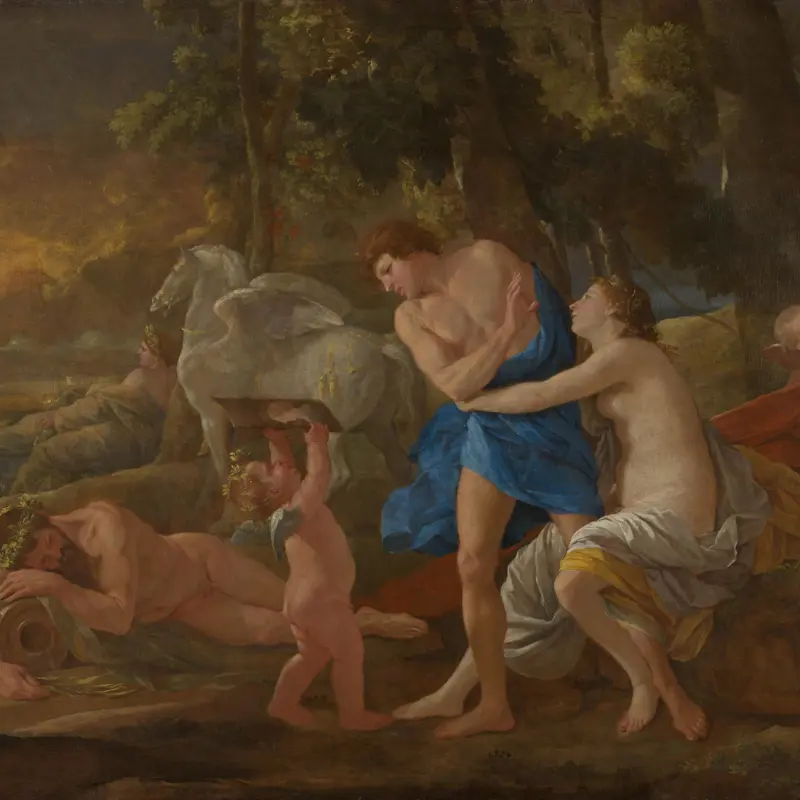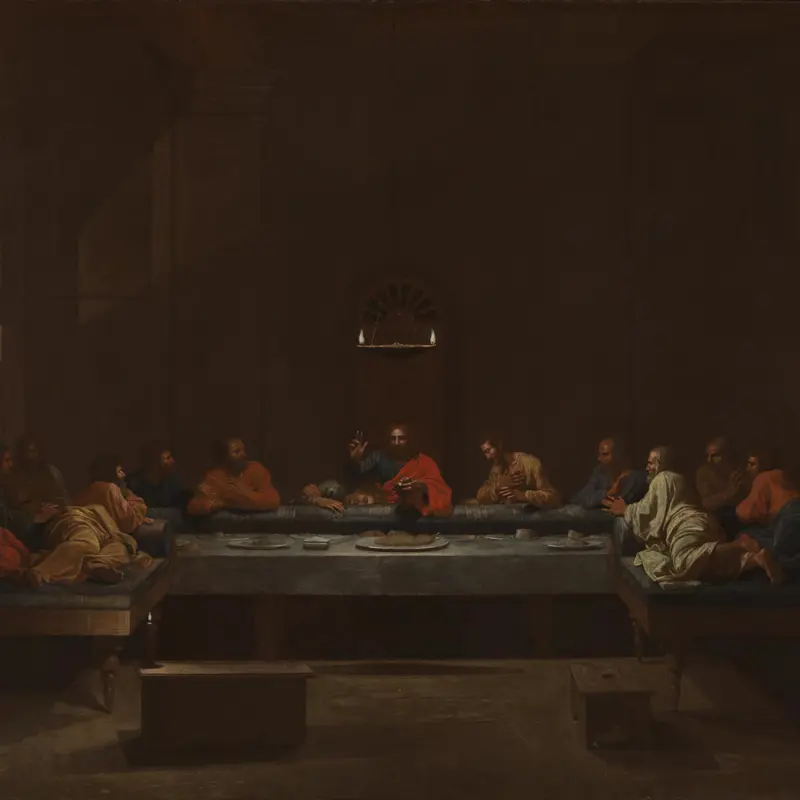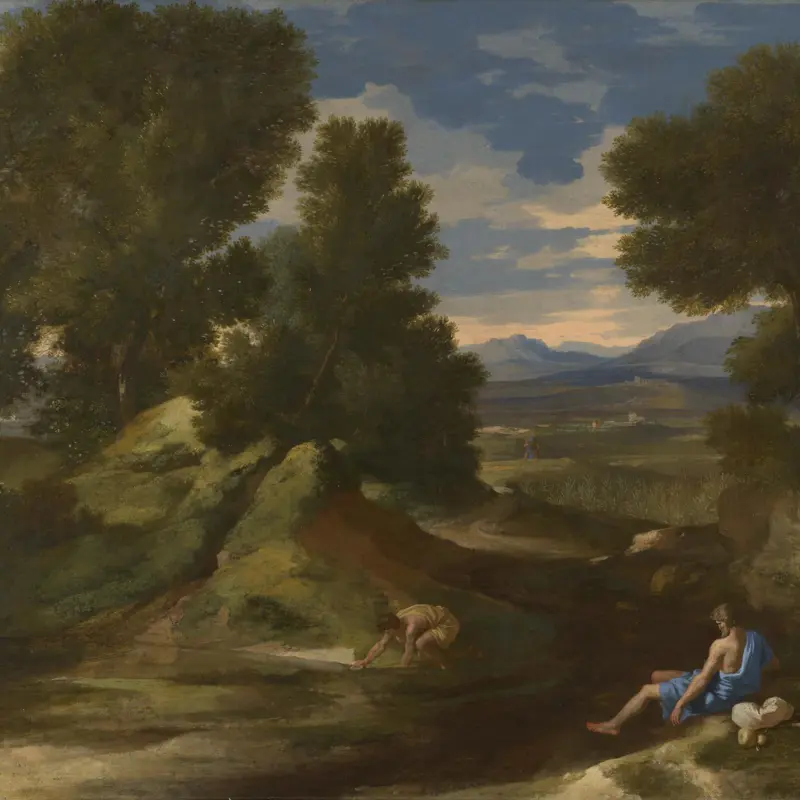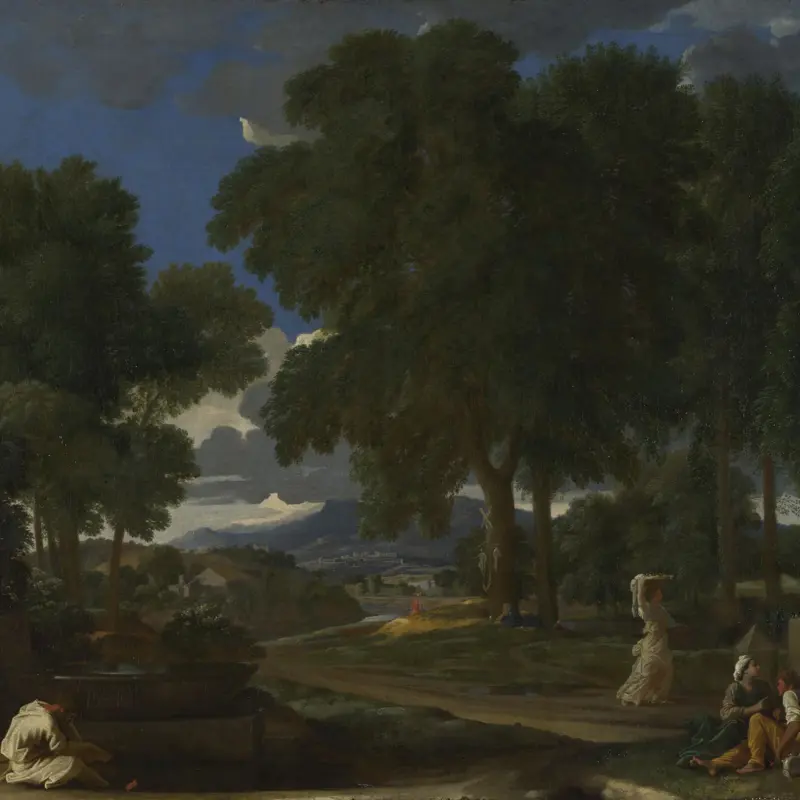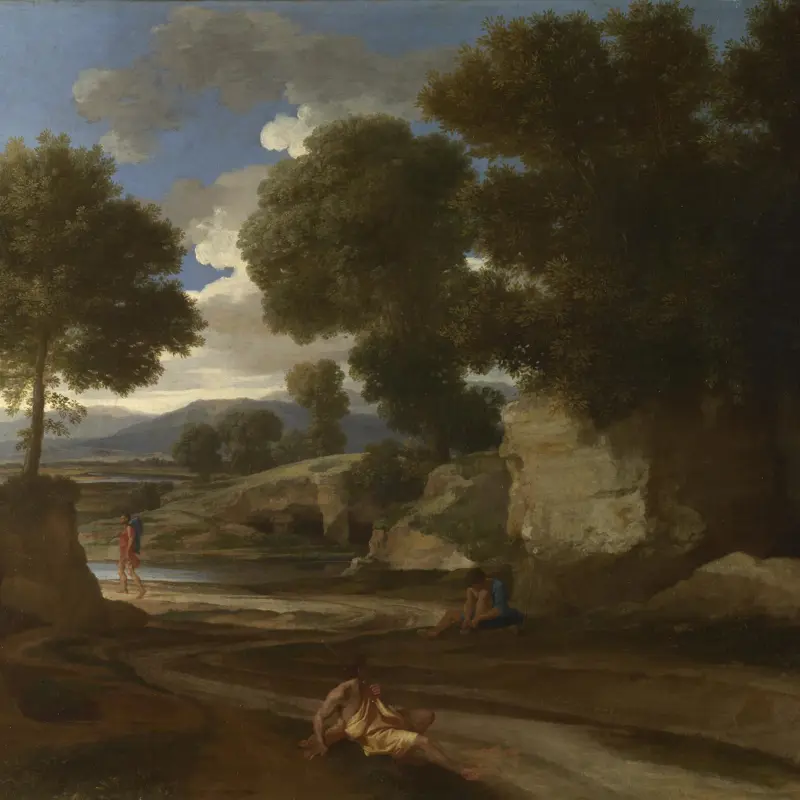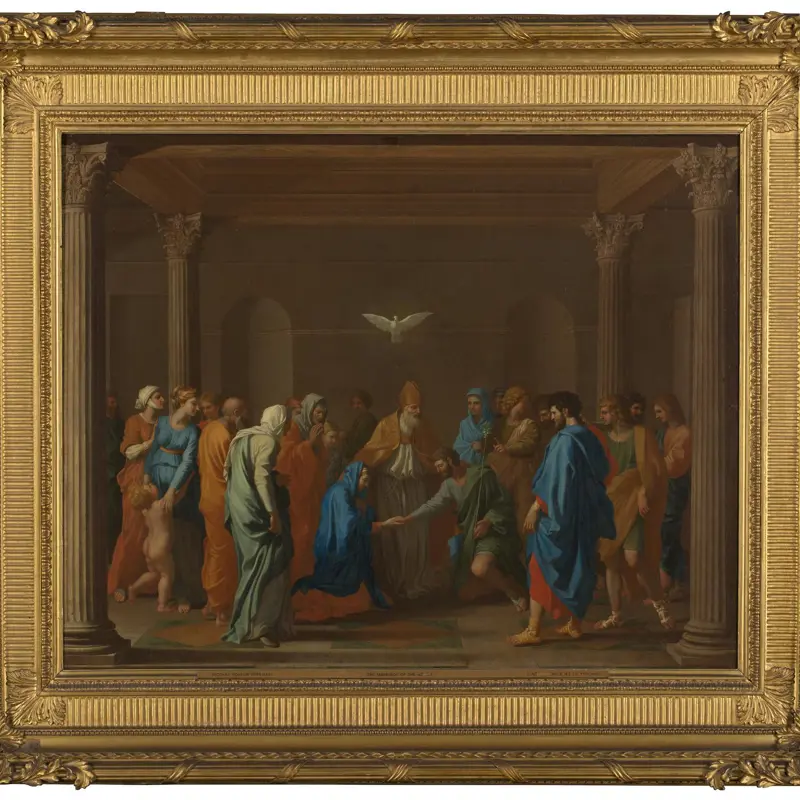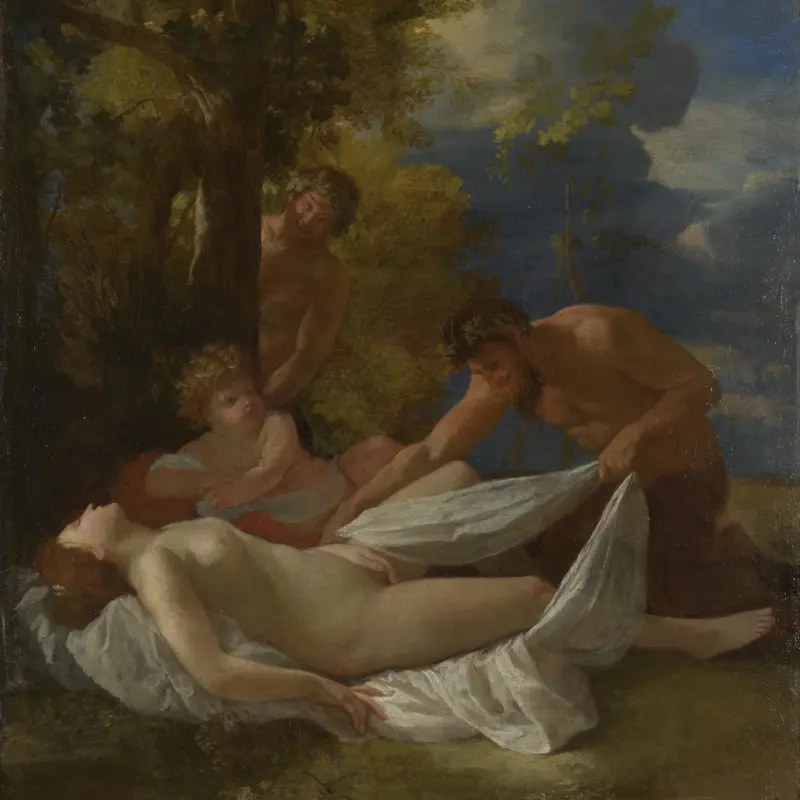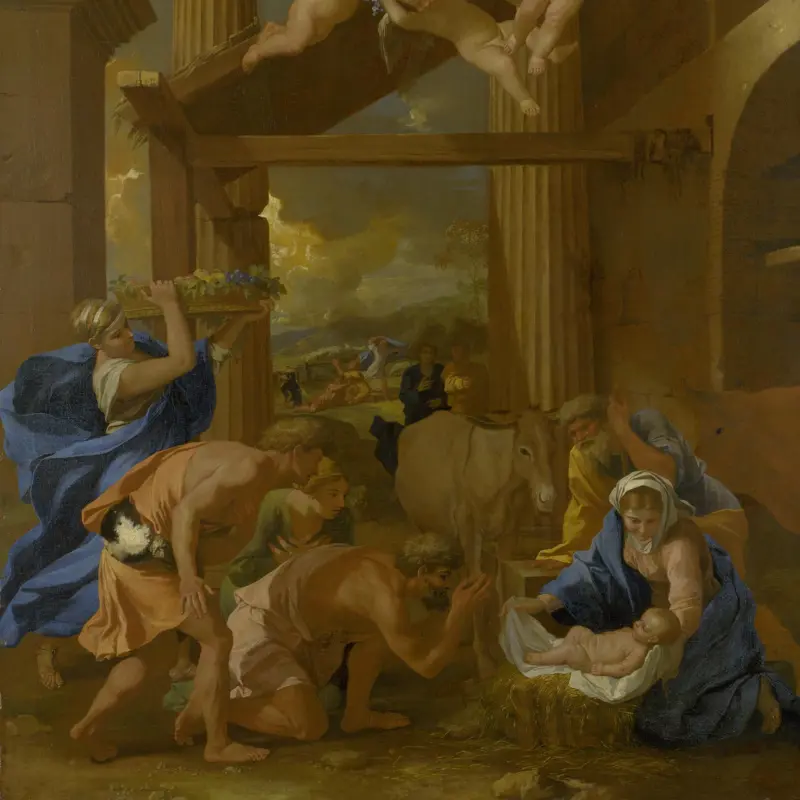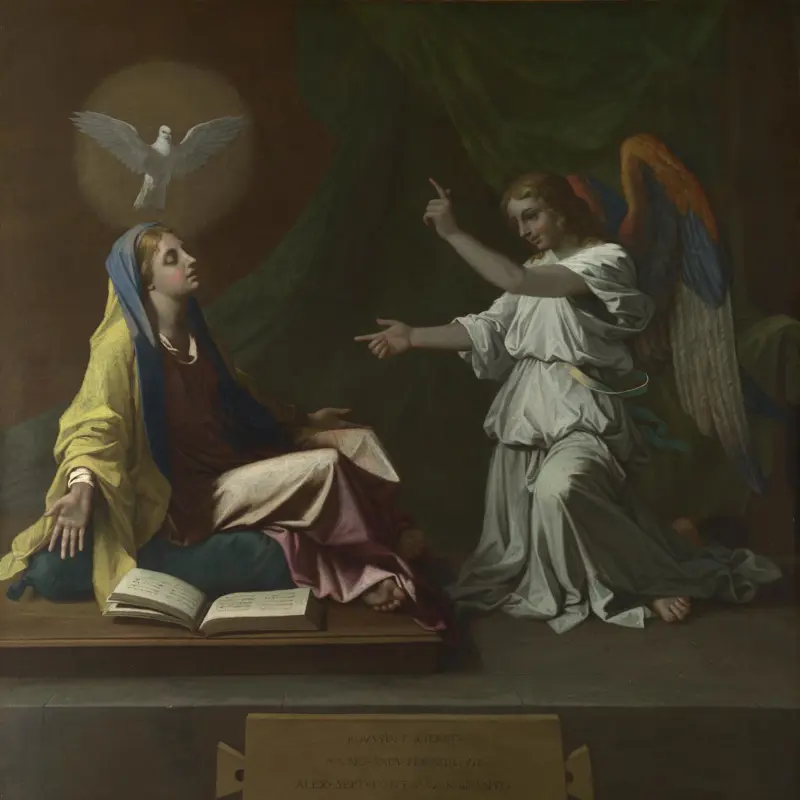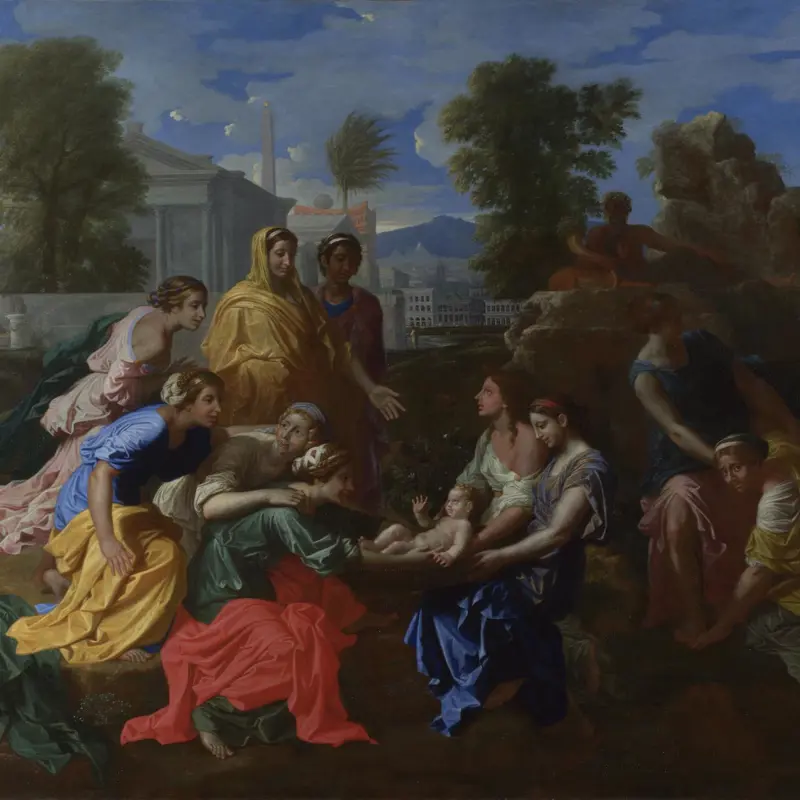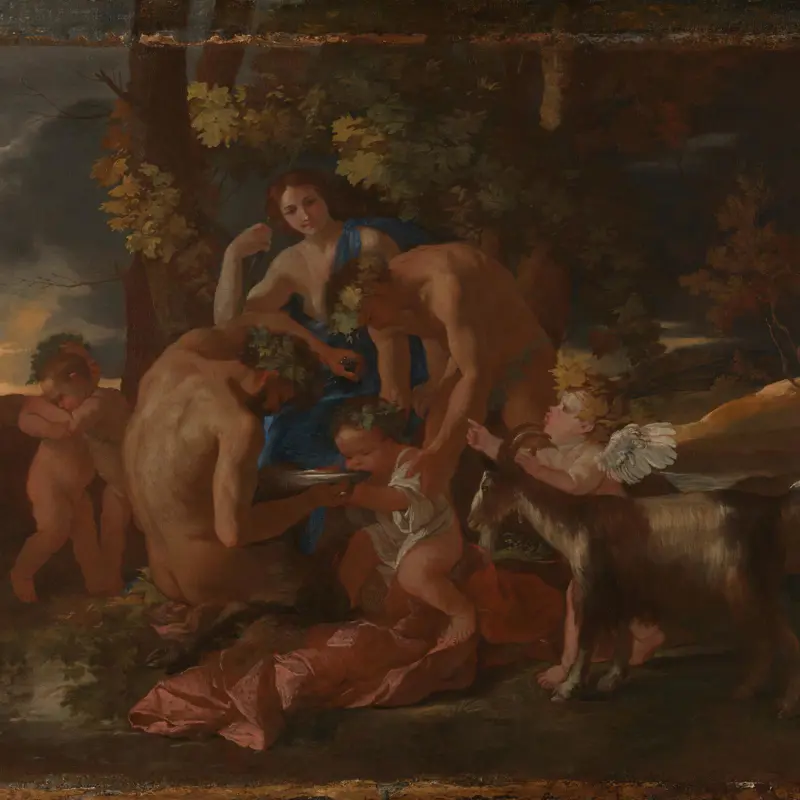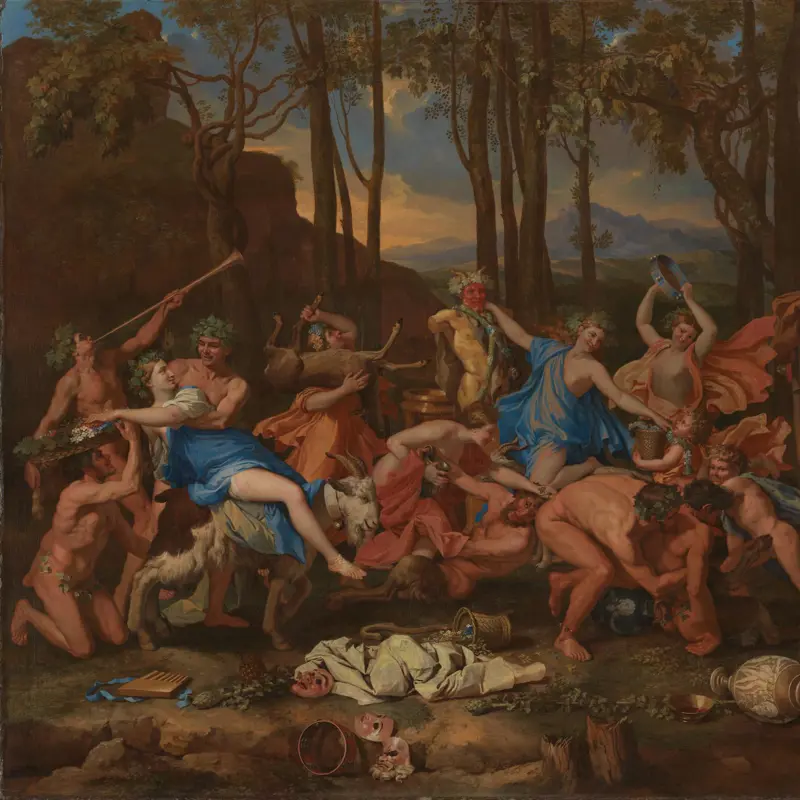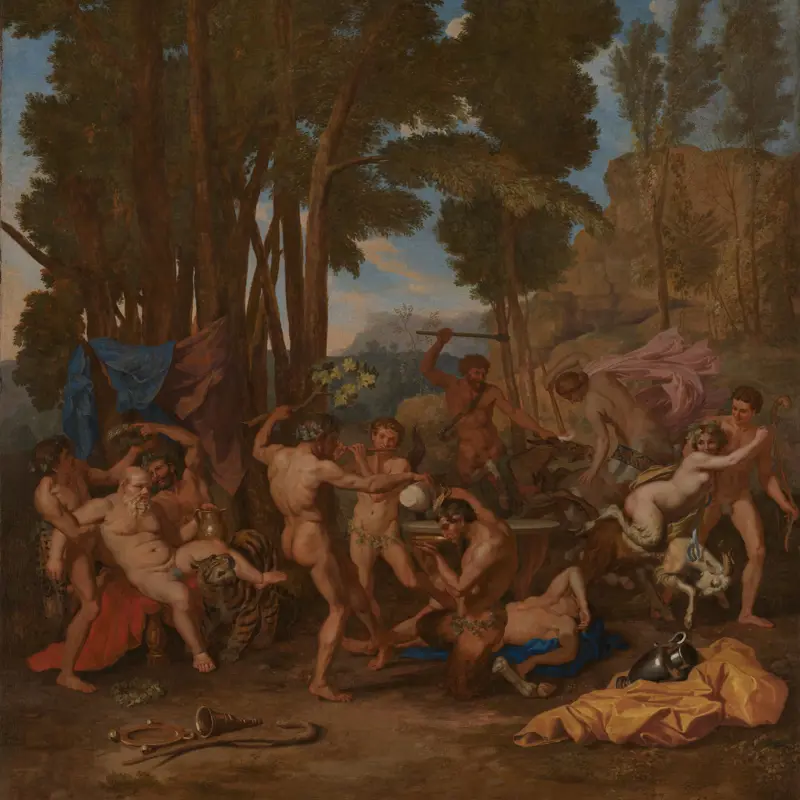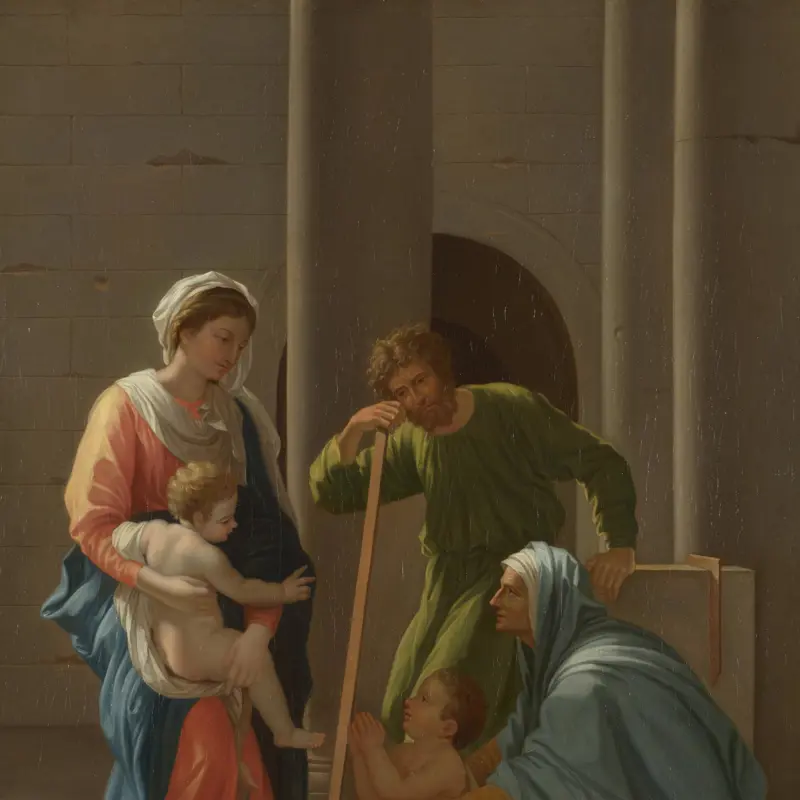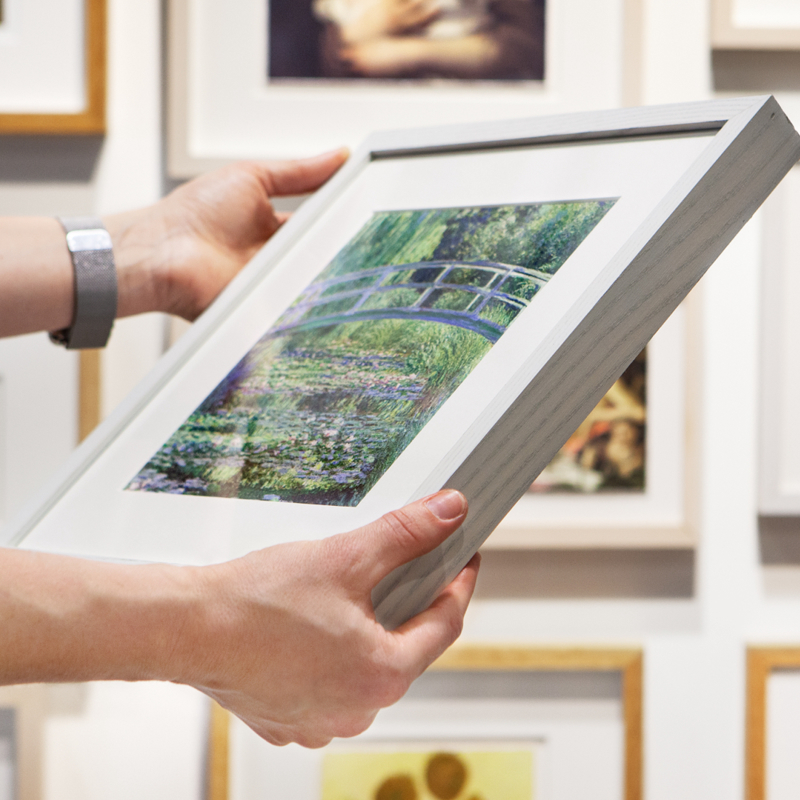Nicolas Poussin, 'The Adoration of the Golden Calf', 1633-4
About the work
Overview
In this scene from the Book of Exodus, a large gathering of Israelites worship a life-size statue of a golden calf, or what is actually a bull, which represents the Egyptian bull-god Apis. They have decided to worship a different, pagan god while their leader Moses has been away on Mount Sinai collecting the stone tablets on which God has written the Ten Commandments, his laws on how to live properly.
Aaron, dressed in a white cloak, has melted down gold earrings to create the idol. In the top left corner, Moses returns with Joshua, and in his anger at seeing the calf smashes the tablets.
The worshippers dance energetically and we follow their pointed hands across the canvas, which helps to tell the story. One group points towards the altar, leading our eye across the foreground to the dancers and Moses on the left. Poussin’s interest in antique sculpture is conveyed by the muscular bodies, flowing drapery and frieze-like arrangement of the dancers.
Key facts
Details
- Full title
- The Adoration of the Golden Calf
- Artist
- Nicolas Poussin
- Artist dates
- 1594 - 1665
- Date made
- 1633-4
- Medium and support
- oil on canvas
- Dimensions
- 153.4 × 211.8 cm
- Acquisition credit
- Bought with a contribution from the Art Fund, 1945
- Inventory number
- NG5597
- Location
- Room 29
- Collection
- Main Collection
- Frame
- 18th-century French Frame
Provenance
Additional information
Text extracted from the ‘Provenance’ section of the catalogue entry in Humphrey Wine, ‘National Gallery Catalogues: The Seventeenth Century French Paintings’, London 2001; for further information, see the full catalogue entry.
Exhibition history
-
2021Poussin and the DanceThe National Gallery (London)9 October 2021 - 3 January 2022J. Paul Getty Museum (Los Angeles)15 February 2022 - 8 May 2022
Bibliography
-
1672G.P. Bellori, Le vite de'pittori, Rome 1672
-
1687G. Brice, Description nouvelle de ce qu'il y a de plus remarquable dans la ville de Paris, Paris 1687
-
1725A. Félibien, Entretiens sur les vies et sur les ouvrages des plus excellens peintres, Trévoux 1725
-
1829
J. Smith, A Catalogue Raisonné of the Works of the Most Eminent Dutch, Flemish, and French Painters: In Which is Included a Short Biographical Notice of the Artists, with a Copious Description of Their Principal Pictures […], 9 vols, London 1829-1842
-
1854G.F. Waagen, Treasures of Art in Great Britain: Being and Account of the Chief Collections of Paintings, Drawings, Sculptures, Illuminated Mss. […], vol. 2, trans. E. Eastlake, London 1854
-
1871Royal Academy of Arts, Exhibition of the Works of the Old Masters associated with the Works of Deceased Masters of the British School (exh. cat. Royal Academy of Arts, 1871), London 1871
-
1903Royal Academy of Arts, Exhibition of Works by the Old Masters and Deceased Masters of the British School (exh. cat., Royal Academy of Arts, January 1903 - March 1903), London 1903
-
1909W.B. Squire, Catalogue of the Pictures at Longford Castle, London 1909
-
1910W. Barclay (ed.), Catalogue of the Earl of Radnor's Collection of Pictures, London 1910
-
1914O. Grautoff, Nicolas Poussin: Sein Werk und sein Leben, Munich 1914
-
1933Royal Academy of Arts, Commemorative Catalogue of French Art (exh. cat. Royal Academy of Arts, January - March 1932), London 1933
-
1946Martin Davies, National Gallery Catalogues: French School, London 1946
-
1951A. Blunt, Nicolas Poussin: The Adoration of the Golden Calf, London 1951
-
1955The National Gallery, The National Gallery: 1938-1954, London 1955
-
1957Martin Davies, National Gallery Catalogues: French School, 2nd edn (revised), London 1957
-
1960D. Mahon, 'Poussin's Early Development: An Alternative Hypothesis', The Burlington Magazine, CII/688, 1960, pp. 288-306
-
1963C. Dempsey, 'Poussin and Egypt', Art Bulletin, XLV/2, 1963, pp. 109-19
-
1963G. Kauffmann, 'Peruzzis Musenreigen', Mitteilungen des Kunsthistorischen Institutes in Florenz, XI, 1963, pp. 55-61
-
1964C. Dempsey, Nicolas Poussin and the Natural Order, Ann Arbor 1964
-
1964F. Philipp, 'Poussin's "Crossing of the Red Sea"', in F. Philipp and J. Stewart (eds), Essays and Studies in Honour of Daryl Lindsay, Melbourne 1964, pp. 80-99
-
1965D. Mahon, 'The Dossier of a Picture: Nicolas Poussin's "Rebecca al Pozzo"', Apollo, LXXXI/37, 1965, pp. 196-205
-
1966A. Blunt, The Paintings of Nicolas Poussin: A Critical Catalogue, London 1966
-
1969K. Badt, Die Kunst des Nicolas Poussin, Cologne 1969
-
1974J. Thuillier, L'opera completa di Poussin, Milan 1974
-
1979J. Mills and R. White, 'Analyses of Paint Media', National Gallery Technical Bulletin, III, 1979, pp. 66-7
-
1980D. Wild, Nicolas Poussin: Band I, Leben, Werk, Exkurse, Band II, Katalog der Werke, Zürich 1980
-
1982M. Fumaroli, 'Muta eloquentia: La représentation de l'éloquence dans l'œuvre de Nicolas Poussin', Bulletin de la Société de l'Histoire de l'Art Français, 1982, pp. 29-48
-
1987M. Podro, 'Depiction and the Golden Calf', in A. Harrison (ed.), Philosophy and the Visual Arts: Seeing and Abstracting, Dordrecht 1987, pp. 13ff
-
1989D. Freedberg, The Power of Images: Studies in the History and Theory of Response, Chicago 1989
-
1990O. Bätschmann, Nicolas Poussin: Dialectics of Painting, London 1990
-
1994E. Langmuir, The National Gallery Companion Guide, London 1994
-
1994T.P. Olson, Nicolas Poussin, His French Clientele and the Social Construction of Style, Ann Arbor 1994
-
1994A. Schnapper, Curieux du Grand Siècle: Collections et collectionneurs dans la France du XVIIe siècl, Paris 1994
-
1994J. Thuillier, Nicolas Poussin, Paris 1994
-
1994R. Verdi and P. Rosenberg, Nicolas Poussin, 1594-1665 (exh. cat. Galeries Nationales du Grand Palais, 27 September 1994 - 2 January 1995; Royal Academy of Arts, 19 January - 9 April 1995), Paris 1994
-
1995A. Cifani and F. Monetti, 'Two Unpublished Paintings by Pietro da Cortona and G. F. Romanelli', The Burlington Magazine, CXXXVII/1110, 1995, pp. 612-6
-
1995R. Beresford, A Dance to the Music of Time by Nicolas Poussin (exh. cat. Wallace Collection, 11 January - 9 April 1995), London 1995
-
1996A. Cifani and F. Monetti, 'Poussin dans les collections piémontaises aux XVIIe, XVIIIe et XIXe siècles', in A. Mérot (ed.), Nicolas Poussin (1595-1665): Actes du Colloque organisé au Musée du Louvre, 1994, Paris 1996
-
1997N. Penny, Frames, London 1997
-
1998M.F. Dell'Arco, Pietro da Cortona e i cortoneschi, Rome 1998
-
1999J. Wallis, 'The Mind and Soul of Romney's Art and the Poussin Connection', Transactions of the Romney Society, IV, 1999, pp. 4-11
-
1999M. Bull, 'Notes on Poussin's Egypt', The Burlington Magazine, CXLI/1158, 1999, pp. 537-41
-
2000J. Bernstock, Poussin and French Dynastic Ideology, Oxford 2000
-
2000A. Cifani and F. Monetti, 'The Dating of Amedeo dal Pozzo's Paintings by Poussin, Pietro da Cortona and Romanelli', The Burlington Magazine, CXLII/1170, 2000, pp. 561-4
-
2001
C. Baker and T. Henry, The National Gallery: Complete Illustrated Catalogue, London 2001
-
2001H. Wine, National Gallery Catalogues: The Seventeenth Century French Paintings, London 2001
-
2001V.C. Gardner Coates, 'A Painting Reserved for "Nobil Diletto": Poussin's "Moses and Aaron Before Pharaoh" for Camillo Massimo', Gazette des beaux-arts, CXLIII/1594, 2001, pp. 185-202
-
2002M. Bull, 'Poussin and Josephus', Gazette des beaux-arts, CXXXIX/1599, 2002, pp. 331-8
-
2003P. Joch, Methode und Inhalt: Momente von künstlerischer Selbstreferenz im Werk von Nicolas Poussin, Hamburg 2003
-
2003C. Pace, 'Collecting French Seventeenth-Century Paintings for the Nation', Art History, XXVI/2, 2003, pp. 281-315
-
2005K. Krause, 'Die "Histoire de Moïse" des Nicolas Poussin', Münchner Jahrbuch der Bildenden Kunst, LVI, 2005, pp. 139-66
-
2008K. Jonckheere, The Auction of King William's Paintings, 1713: Elite International Art Trade at the End of the Dutch Golden, Amsterdam 2008
-
2009P. Curtis (ed.), On the Meanings of Sculpture in Painting (exh. cat., Henry Moore Institute, Leeds), Leeds 2009
Frame
This magnificent French Regency frame dates to around 1710. Carved in oak, the back edge is decorated with alternating flower heads in cabochons (egg-and-nest).
The corner cartouches are adorned with palmettes as the main motif, complemented by scrolls of cabochons, pierced leaves and a shell at the tip, with pierced scrolls on either side. Decorating the frieze are flower heads, scrolls, tendrils, husks, male heads with winged ears and feathered crowns, small cartouches with palmettes and ‘décor mosaique en croisillons’. The centre cartouche showcases a rosette with husks and palmettes. A shell motif and C-scrolls connect to winged heads. The sight edge is adorned with French acanthus leaves.
The frame features engraved veins in the leaves and flowers, meticulously crafted by a specialist known as a ‘répareur’. These details accentuate the backdrop, with its cross-hatching and fine parallel lines showcasing an array of fine ornaments. The original water gilding is burnished on the highlights, leaving matt areas to create depth. Additionally, some punch-tooling can be found on the gold surface.
This frame is one of a pair of identical French Regency frames made for Poussin’s The Adoration of the Golden Calf and its companion, The Crossing of the Red Sea (National Gallery of Victoria, Melbourne). The frames were commissioned by Jean-Baptiste le Ragois de Bretonvilliers for the redecoration of his Parisian apartment around 1710; the paintings remained together until they were sold in 1945. The richness of this frame (and its pair) is a testament to the unparalleled skill of master craftsmen from Paris. This contrasts with Poussin’s preference for simpler frames with matt gilding, as indicated in his letters and depicted in the background of his self portrait (Musée du Louvre, Paris).
About this record
If you know more about this work or have spotted an error, please contact us. Please note that exhibition histories are listed from 2009 onwards. Bibliographies may not be complete; more comprehensive information is available in the National Gallery Library.

